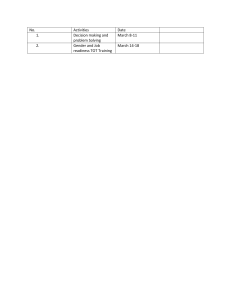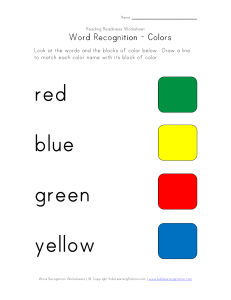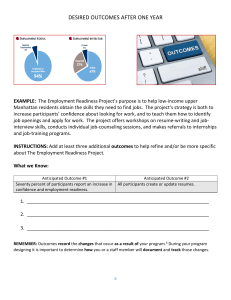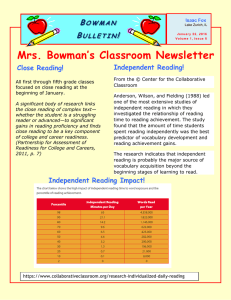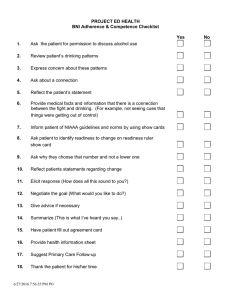Teacher Readiness & Student Achievement in Vocational Schools
advertisement
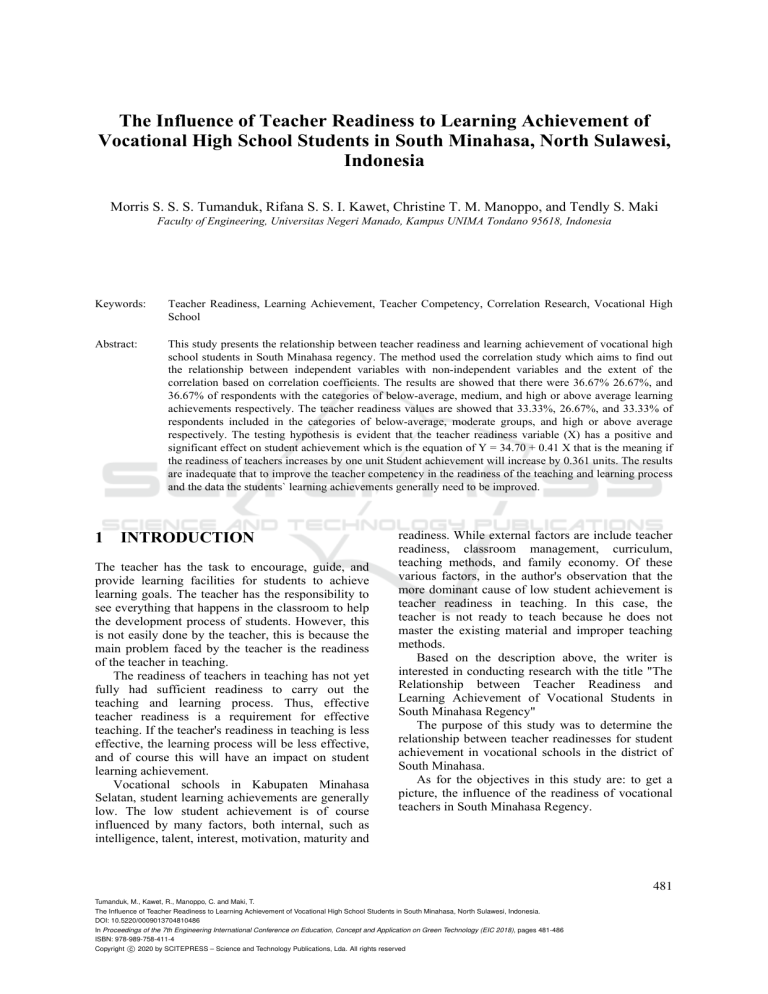
The Influence of Teacher Readiness to Learning Achievement of Vocational High School Students in South Minahasa, North Sulawesi, Indonesia Morris S. S. S. Tumanduk, Rifana S. S. I. Kawet, Christine T. M. Manoppo, and Tendly S. Maki Faculty of Engineering, Universitas Negeri Manado, Kampus UNIMA Tondano 95618, Indonesia Keywords: Teacher Readiness, Learning Achievement, Teacher Competency, Correlation Research, Vocational High School Abstract: This study presents the relationship between teacher readiness and learning achievement of vocational high school students in South Minahasa regency. The method used the correlation study which aims to find out the relationship between independent variables with non-independent variables and the extent of the correlation based on correlation coefficients. The results are showed that there were 36.67% 26.67%, and 36.67% of respondents with the categories of below-average, medium, and high or above average learning achievements respectively. The teacher readiness values are showed that 33.33%, 26.67%, and 33.33% of respondents included in the categories of below-average, moderate groups, and high or above average respectively. The testing hypothesis is evident that the teacher readiness variable (X) has a positive and significant effect on student achievement which is the equation of Y = 34.70 + 0.41 X that is the meaning if the readiness of teachers increases by one unit Student achievement will increase by 0.361 units. The results are inadequate that to improve the teacher competency in the readiness of the teaching and learning process and the data the students` learning achievements generally need to be improved. 1 INTRODUCTION The teacher has the task to encourage, guide, and provide learning facilities for students to achieve learning goals. The teacher has the responsibility to see everything that happens in the classroom to help the development process of students. However, this is not easily done by the teacher, this is because the main problem faced by the teacher is the readiness of the teacher in teaching. The readiness of teachers in teaching has not yet fully had sufficient readiness to carry out the teaching and learning process. Thus, effective teacher readiness is a requirement for effective teaching. If the teacher's readiness in teaching is less effective, the learning process will be less effective, and of course this will have an impact on student learning achievement. Vocational schools in Kabupaten Minahasa Selatan, student learning achievements are generally low. The low student achievement is of course influenced by many factors, both internal, such as intelligence, talent, interest, motivation, maturity and readiness. While external factors are include teacher readiness, classroom management, curriculum, teaching methods, and family economy. Of these various factors, in the author's observation that the more dominant cause of low student achievement is teacher readiness in teaching. In this case, the teacher is not ready to teach because he does not master the existing material and improper teaching methods. Based on the description above, the writer is interested in conducting research with the title "The Relationship between Teacher Readiness and Learning Achievement of Vocational Students in South Minahasa Regency" The purpose of this study was to determine the relationship between teacher readinesses for student achievement in vocational schools in the district of South Minahasa. As for the objectives in this study are: to get a picture, the influence of the readiness of vocational teachers in South Minahasa Regency. 481 Tumanduk, M., Kawet, R., Manoppo, C. and Maki, T. The Influence of Teacher Readiness to Learning Achievement of Vocational High School Students in South Minahasa, North Sulawesi, Indonesia. DOI: 10.5220/0009013704810486 In Proceedings of the 7th Engineering International Conference on Education, Concept and Application on Green Technology (EIC 2018), pages 481-486 ISBN: 978-989-758-411-4 Copyright c 2020 by SCITEPRESS – Science and Technology Publications, Lda. All rights reserved EIC 2018 - The 7th Engineering International Conference (EIC), Engineering International Conference on Education, Concept and Application on Green Technology 2 LITERATURE REVIEW 2.1 Teacher Readiness 2.1.1 Materials Preparation The task of the teacher before carrying out certain teaching needs to prepare the material to be taught, this is because it is one of the basic competencies of a teacher. According to Widodo S A (2017), that: "Preparation and teaching planning of teachers is able to provide techniques for presenting material / learning materials that are in accordance with the needs of students". From the above theory, it can be concluded that the material preparation carried out is closely related to a teaching profession as a teaching staff in the school, so as not to misplace the meaning or purpose of learning to be achieved. And every planning or material preparation carried out by a teacher depends on the objectives to be achieved, as stated by Marshall, H. & Weinstein, R. (1984), that: To determine teaching material depends on the objectives to be achieved, individualist structures children / students and educational goals. Teaching planning and material preparation in principle is as one of the foundations for achieving goals, because the goal is a component that is first formulated by the teacher in the teaching and learning process. The role of goals is very important because it determines the direction of the teaching and learning process. A clear goal will also provide clear instructions on the selection of teaching materials, the establishment of teaching methods and teaching aids and provide guidance on assessment. Education and teaching are businesses that have a purpose, more than educational activities and bound teaching and directed to achieve goals. In education we have general guidelines or are common targets to be achieved. This is clearly formulated in the form of general education goals. 2.1.2 Teacher Ability The ability according to Sudjana, (1989) is a qualitative intrinsic representation of teacher behavior that is very meaningful. While. From the above understanding, it can be said that the teacher's ability is the ability or the power possessed by a teacher to carry out a teaching action. In this case a teacher must have the ability to teach, because this is closely related to the results that will be achieved by the teacher as a teacher and students in the achievement of learning. 482 The learning process and student learning outcomes are not only determined by the structure pattern and curriculum content but are also determined by the competence of teachers who teach and guide them. It is clear that the teacher is a very important part and is responsible for the success or failure of the teaching and learning process. Therefore the teacher must have the ability in teaching quality and professional Widodo S A (2017). 1. Dominate Materials Before the teacher appears in front of the class to manage the interaction of teaching and learning, first must have mastered what material will be given and what materials can support the course of the teaching and learning process. By mastering the material, the teacher can convey the subject matter dynamically. In this case what is meant is mastering the material, for a teacher will contain two spheres of mastery of matter. There are two scope of control in question: 1) Mastering the field of study in the curriculum. 2) Mastering enrichment / supporting material in the field of study Mastering the material in the field of study in the curriculum in question in this case the teacher must master the material or the branch of knowledge held by him, in accordance with what is stated in the curriculum in the school. 2. Managing Teaching and Learning Programs A competent teacher is required to also be able to manage teaching and learning programs that will be implemented so that in the learning process what is the goal will be achieved. The steps that must be taken by a teacher in managing the teaching and learning program are: 1. Formulate instructional / learning objectives. 2. Get to know and can use the right instructional process. 3. Carry out the teaching and learning process. 4. Get to know the ability of students. 5. Plan and implement a remedial program. 3. Manage Classes To teach a class, the teacher is required to be able to manage the class, which is to provide conducive conditions for the teaching and learning process. If it is not conductive, then the teacher must try as optimally as possible to correct it. Therefore, classroom management activities will involve arranging an adequate The Influence of Teacher Readiness to Learning Achievement of Vocational High School Students in South Minahasa, North Sulawesi, Indonesia classroom system for teaching and creating a harmonious teaching and learning climate. The problem of managing classes is not a light task. Various factors are that cause the complexity. In general, the factors that influence classroom management are divided into two groups, namely Aldo Enrico (2014: 5), student internal factors and student external factors. Internal student factors are related to emotional, thought, and behavioural problems. Students' personalities with their respective characteristics lead students to be from other students individually. This difference between individuals is seen from biological, intellectual, and psychological differences. While the external factors of students are related to problems in the atmosphere of the learning environment, student placement, grouping of students, number of students in the class, and so on. The problem of the number of students in the class will colour the dynamics of the class, and the more number of students in the class, for example 30 people tend to be younger and conflict occurs. Conversely, the fewer numbers of students in the classroom tend to be smaller in conflict. As long as there is an effort from the teacher, chaos in the class can certainly be overcome. Admittedly, class, from time to time, from day to day, today, tomorrow, or the day after tomorrow, always shows a different atmosphere. Yesterday the class atmosphere was calm. Maybe today the atmosphere of class is noisy and hot. At times, the learning goodness of students is interrupted by the coming of disturbances from outside the classroom in various forms and types, for example there are fires around the school, there are thieves in broad daylight, and there is a motor vehicle collision and its luggage. 2.2 Student Learning Achievement Learning is an important process for changing human behaviour and includes everything that is thought and done. Learning plays an important role in development, habits, attitudes, beliefs, goals, personality, and even human perception. Learning according to James, W. (1890), "Learning may be defined as the process by which behavior originates or is through training or experience. Learning can be defined as the process of generating or changing behavior through practice or experience. Learning is a mental / psychic activity in active interaction with the environment, which results in changes in understanding knowledge, skills and attitudes. Learning is a series of activities of the soul of the body to obtain a change in behaviour as a result of individual experience in interaction with the environment concerning cognitive, affective, and psychomotor. Bjorklund, D.F. (1995), also formulates the notion of learning, namely a business process carried out by individuals to obtain a new behaviour change as a whole as a result of the individual's own experience in interaction with the environment. From some of the opinions above it can be concluded that learning is a process of change in human beings that appears in behavioural changes such as habits, knowledge, attitudes, skills, and thinking power. 2.2.1 Learning Learning can be in the form of students, learners, learning citizens, and trainees. Learners have sensory organs that are used to capture brain stimuli that are used to transform their sensing results into complex memory and the nerves or muscles used to display performance that shows what has been learned. 2.2.2 Stimulus Events that stimulate learner sensing are called stimulus situations. Examples of these stimuli are sound, light, color, heat, cold, plants, buildings, and people. In order for learners to be able to learn optimally, they must focus on certain stimuli that are of interest. 2.2.3 Memory Learning memory contains various abilities in the form of knowledge, skills, and attitudes that result from previous learning activities. 2.2.4 Response Response is an action that results from memory actualization. The learner who is observing the stimulus, then the memory inside him then responds to the stimulus. 3 METHOD This research is correlation research which aims to find out whether there is a relationship between independent variables with non-independent variables and the extent of the correlation between 483 EIC 2018 - The 7th Engineering International Conference (EIC), Engineering International Conference on Education, Concept and Application on Green Technology independent variables with non-independent variables based on correlation coefficients. The variables examined in this research field consist of 2 variables: 1. Independent variable: Teacher readiness (X) Teacher readiness is an effort made by the teacher, especially the subject of Building Construction to help create optimal learning conditions so that the goals of teaching can be achieved, with the following indicators: 1) Preparation of material, 2) Manage teaching and learning programs, 3) Manage the class, 4) Using media / sources, 5) Mastering the educational foundation 6) Manage teaching and learning interactions 7) Assessing student learning achievement for teaching purposes. Completeness instruments for Teacher Readiness are developed by compiling items that are based on indicators from the Teacher Readiness variable. For this variable the statement uses a Likert scale. For positive statements, the score is as follows: Very often =4 Often =3 Almost never =2 Never =1 For negative statements the score is opposite to a positive statement. The number of items in the class management completeness instrument is 30 items. For negative statements the score is opposite to a positive statement. The number of instrument items for teacher readiness is 25 items. Instrument lattice can be seen in table 1. 2. Non-independent variables: Learning achievement (Y). Data from the instrument of learning achievement was taken through report card grades of Basic Competency in class XI Vocational School in South Minahasa Regency. The sampling technique in this study is by the technique of "Side Judgment Purposive". In this case a sample based on consideration is most appropriate to the purpose of the study. Thus the sample taken is all students of class XI Vocational High School in South Minahasa Regency who take the Basic Competency subject in 2017. To obtain the data needed in this study, questionnaire and documentation instruments were used, namely Teacher Readiness variables using questionnaires, and learning achievement using documentation (Report Card Score). For the purposes of analyzing data, simple linear regression analysis and product moment correlation techniques are used, with the formula in Sujana (1986: 236), as follows: This correlation analysis is intended to determine the relationship between two variables, in this case the relationship between teacher readiness and student learning achievement. Furthermore, variance analysis is conducted with the intention to find out whether the results obtained are correct so that they can be used to estimate or predict student learning achievement if the teacher readiness results are known, it will show that the regression model is good enough and can be used to estimate or predict learning achievement (Y) if the teacher's readiness (X) is known. Table 1: The teacher's readiness grid. Indicator Material Preparation Manage the Teaching and Learning Process Classroom Manage Using Media / Resources Mastering the Educational Platform Manage Teaching and Learning Interactions Assessing Student Learning Achievement Total 484 Item Number Positive Negative 1, 2 3 6, 8, 23 7 Total 3 4 9, 10, 16 25 20, 22 19 17 21 4 2 3 11, 12, 24 15 4 5, 14 5 8 25 4, 13, 18 17 4 RESULTS AND DISCUSSION The variable readiness of the teacher shows the highest score of 78 and the lowest of 65. After calculating the average price is 71, 73. Standard deviation = 1 + 3.3 Log n = 1 + 3.3 Log 30 = 5.88 = 5 or 6, taken 5. Length of Class Interval = (79-65) / 5 = 2.80 rounded 3. The copyright form is located on the authors’ reserved area. Based on Table 2, it can be seen that around 33.33% of teachers' readiness is above average, and The Influence of Teacher Readiness to Learning Achievement of Vocational High School Students in South Minahasa, North Sulawesi, Indonesia 66.67% is below the average. If the data is grouped into 3 categories, the high score is 33.33% (score 7479); medium 36, 67% (score 71-73); and low 30.00% (score 65-70). Data of student learning achievement for basic competency subjects showed the highest score of 81 and the lowest of 60 after being calculated using a fx 3800P calculator, the average score was 70.33. Table 2: Distribution of Teacher Readiness Frequency. Class Interval 65 – 67 68 – 70 71 – 73 74 – 76 77 - 79 Total No. 1 2 3 4 5 Absolute Frequency 4 5 11 9 1 30 Relative Frequency (%) 13.33 16.67 36.67 30.00 3.33 100.00 Figure 1: Teacher Readiness Data Histrogram. Table 3: Distribution frequency of student learning achievement. No. 1 2 3 4 5 Class Interval 60 – 64 65 – 68 69 – 72 73 – 76 77 - 81 Total Absolute Frequency 5 6 8 7 4 30 Relative Frequency (%) 16.67 20.00 26.67 23.33 13.33 100.00 Figure 2: Student Learning Achievement Data Histrogram. Standard deviation = 1 + 3.3 Log n = 1 + 3.3 Log 30 = 5.88 = 5 or 6, taken 5. Length of Interval = (81-60) / 5 = 4.20 rounded 4 The results of the frequency distribution of student learning achievement can be seen in Table 4.2. Based on table 4.2, it can be seen that there are 36.67% above the average, and 63.33% below the average. If the scores are grouped into 3 categories then students who have high achievement are 36.67% (score 73-81); medium 26.67% (score 6972); low 36.67% (score 60-64). From the calculation of regression coefficient analysis in appendix 7, the results can be stated as follows: ỷ = 34.70 + 0.41 X The results above illustrate that if the teacher's readiness increases by one unit, then the average student achievement will increase by 0.361 units. Analysis of variance is carried out with the intention to find out whether the results obtained above are appropriate so that they can be used to estimate or predict student learning achievement if teacher readiness is known, with results (see Appendix 7, p. 45). These results show that the regression model is good enough, because based on the model deviation test shows that the deviation is not real at the 5% level in this case F (Calculate) = 0.73 <F (Table) = 2.43. Thus, the regression equation above can be used to estimate or predict learning achievement (Y) if teacher readiness (X) is known. As for the test of the regression model, it shows that the model is real or significant at the 5% test level, in this case F (Calculate) = 101.45> F (Table) = 4.20. This correlation analysis is intended to determine the relationship between two variables, in this case the relationship between teacher readiness and student learning achievement, with the following formula: The results above show that r2 = 0.70, this means that the regression model has been able to explain the diversity of student learning achievement around 70% or in other words that the teacher's readiness contributes to student learning achievement by 70%. The results of the description of the data of the value of student learning achievement shows that out 485 EIC 2018 - The 7th Engineering International Conference (EIC), Engineering International Conference on Education, Concept and Application on Green Technology of 30 respondents there were 11 or 36.67% of respondents included in the category of underaverage learning achievement. 8 or 26.67% of respondents included in the category of moderate group, and 11 or 36.67% of respondents entered the high achievement category or above the average. From the results of the description of the data the students' learning achievements generally need to be improved. The results of the description of the data the teacher readiness value shows that out of 30 respondents there were 9 or 33.33% of respondents included in the category of teacher readiness below the average, 11 or 26.67% respondents who entered the category of moderate groups, and 10 or 33, 33% of respondents entered the high or above average category. From the results of the description of the data, it shows that the readiness of the teacher is inadequate and needs to improve teacher competency in the readiness of the teaching and learning process. Based on the results of hypothesis testing, it is evident that teacher readiness variables (X) have a positive and significant effect on student achievement, this can be explained as follows: Based on the results of simple linear regression analysis of teacher readiness variables and Vocational Student Achievement in District South Minahasa obtained the regression line equation ỷ = 34.70 + 0.41 X, which illustrates that if the teacher's readiness increases by one unit the student's learning achievement will increase by 0.361 units. Similarly, the results obtained are that the regression model is good enough, because based on the model deviation test shows that the deviation is unreal at the 5% level in this case F (Calculate) = 0.73 <F (Table) = 2.43. Thus, the regression equation above can be used to estimate or predict learning achievement (Y) if teacher readiness (X) is known. Similarly, to test the regression model, it shows that the model is real or significant at the 5% test level, where F (Calculate) = 101.45> F (Table) = 4.20., With a coefficient of determination of r2 = 0, 70, this means that the regression model has been able to explain the diversity of student learning achievement around 70% or in other words that teacher readiness influences Learning Achievement of Vocational Students in South Minahasa District by 70%. 5 CONCLUSION Based on the theoretical description and results and discussion, the conclusions of this study can be formulated as follows: that there is a significant and 486 positive relationship between teacher readiness and learning achievement of vocational students in South Minahasa Regency. Need to increase teacher competency in the readiness of the teaching and learning process to improve the learning achievement of vocational students in the South Minahasa regency. ACKNOWLEDGEMENTS The authors wish expressed to Prof. Dr. Julyeta P.A. Runtuwene, M.S, DEA as Chancellor of Manado State University who has funded this research and to Prof. Dr. H. Sumual, M.Sc, as Dean of the UNIMA Faculty of Engineering which has provided motivation and recommendations so that this research can be carried out. REFERENCES Aldo, E., Ritchie, A., & Weriyen, O., 2014. “The Factors that Influenced Consumptive Behavior: A Survey of University Students in Jakarta”, International Journal of Scientific and Research Publications, Vol. 4, No. 1, pp. 1-6. Bjorklund, D.F., 1995. Children’s Thinking & Developmental Function and Individual Differences, Pacific Grove, Brooks/Cole Publishing Company. 2nd edition. James, W., 1890. The principles of psychology, Holt. (Reprinted 1950, Dover Publications). New York. Sudjana, N., 1986, Statistical Method, Tarsito. Bandung. Sudjana, N., 1989, PBM Basics. New Light. Bandung. Widodo S A, Prahmana R C I, Purnami A S, & Turmudi, 2017. “Teaching materials of algebraic equation”, IOP Conf. Series: Journal of Physics: Conf. Series 943, pp.1-8. Marshall, H. & Weinstein, R., 1984. “Classroom factors affecting students' self-evaluations: an interactional model”, Review of Educational Research, 54, pp.301325.
